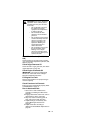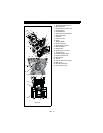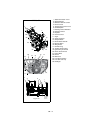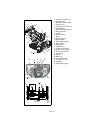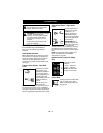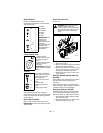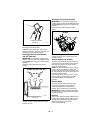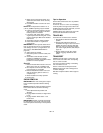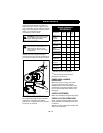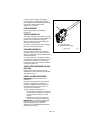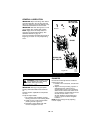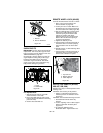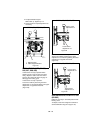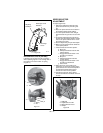
GB - 20
2. Check Function of Clutches
If clutches do not engage or disengage
properly, adjust or repair before operation.
See Attachment Clutch/Brake Adjustment on
page 28 and Traction Drive Clutch
Adjustment on page 30.
3. Check Dual Handle Interlock
Without the engine running, press down
(engage) both clutch levers. Release
attachment clutch lever. Attachment clutch
should remain engaged until traction clutch
lever is released, then both clutches must
disengage.
If clutches do not engage or disengage
properly, adjust or repair before operation
(see Attachment Clutch/Brake Adjustment on
page 28 and Traction Drive Clutch
Adjustment on page 30).
4. Check Remote Wheel Lock
(921005)
Squeeze and release the remote wheel lock
control to lock the left wheel for better traction
when throwing snow or to unlock the left
wheel for easier steering.
If remote wheel lock does not lock or unlock
properly, adjust or repair before operation
(see Remote Wheel Lock (921005) on
page 25).
5. Check Runners
Check and adjust Runners (See Runners on
page 24). Allow 1/8 in. (3 mm) between
scraper blade and hard, smooth surface(s).
Allow 1-1/4 in. (30 mm) between scraper
blade and uneven or gravel surfaces.
6. Check Engine Fuel & Crankcase
Oil
Check and add fuel if required. Check that
the engine crankcase oil is full using dipstick.
Refer to Engine Manual for detailed
instructions.
TO STOP IN AN EMERGENCY
Immediately release both control levers to
stop unit in an emergency. Stop engine,
remove key and wait for all rotating parts to
stop before leaving operator’s position.
STARTING AND SHUT OFF
IMPORTANT: Allow unit and engine to adjust
to the outdoor temperature before clearing
snow. Before shut-off, run the attachment a
few minutes to prevent impeller freeze-up.
NOTE: Try out each control without the
engine running to see how it works and what
it does.
Manual Start
1. Turn discharge chute straight ahead.
2. Make sure that the traction clutch and
attachment drive clutch levers are fully
disengaged.
3. Push Primer Bulb 2 or 3 times for cold
engine.
NOTE: When temperature is below -15° F
(-26° C) additional priming may be needed.
4. If engine is cold, apply choke. See
Engine Manual for detailed instructions.
NOTE: A warm engine requires less choking
than a cold engine.
5. Set throttle to proper starting position.
6. Insert key into ignition switch on engine
and push into "Run" position. DO NOT
twist key after it is inserted.
7. Grasp starter handle and pull rope out
slowly until it pulls harder. Let rope
rewind slowly.
8. Pull rope with a rapid continuous full arm
stroke. Let rope rewind slowly.
IMPORTANT: DO NOT let Starter Handle
snap against Starter.
9. Repeat steps 7 and 8 until engine starts.
(If engine does not start, refer to
TROUBLESHOOTING on page 36.)
10. Adjust choke as needed.
11. Set throttle to Part Throttle or Slow
position for adaptation to outside
temperature or travel. Set throttle to Fast
position for normal operation.
Electric Start (120V)
1. Connect extension cord to starter.
IMPORTANT: Prevent damage to unit. Know
voltage of your starter and only use matching
outlets.
2. Plug extension cord into 120V 3-wire,
grounded outlet.
3. Turn discharge chute straight ahead.
WARNING: AVOID INJURY. Read
and understand the entire Safety
section before proceeding.
WARNING: FAILURE TO
FOLLOW INSTRUCTIONS could
result in personal injury and/or
damage to unit. DO NOT attempt
to start your unit at this time. Read
entire Owner/Operator Manual and
the Engine Manual first.



